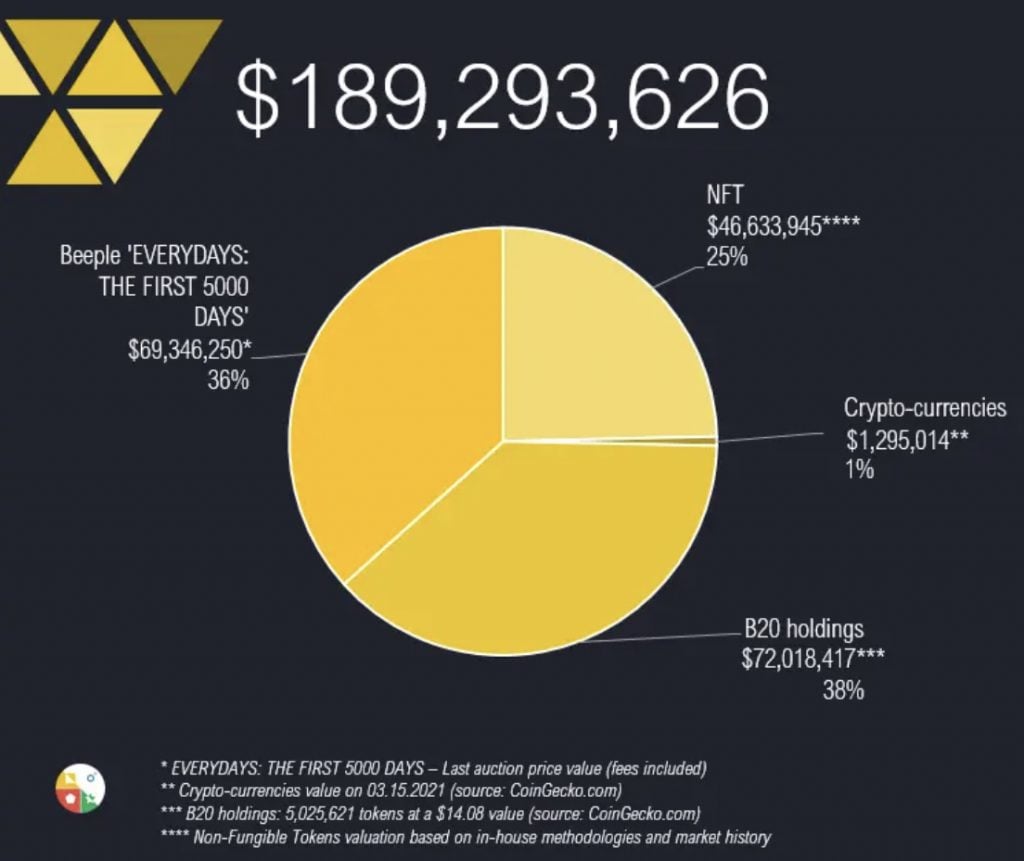Metakovan and Twobadour teamed up to buy for $69.3 million. Here’s what their split tells us about the future of the NFT market
Vignesh Sundaresan and Anand Venkateswaran, once known only by pseudonyms as Metakovan and Twobadour, made waves—or more accurately, a tsunami—when they acquired Beeple’s Weekdays: The first 5,000 days for a whopping $69.3 million at Christie’s in March 2021.
The acquisition immediately shot NFTs ahead of the culture conversation and All days is still the most expensive NFT ever sold. Suddenly, everyone wanted to know: who are these guys?
In the year and a half since their headline purchase, Metakovan and Twobadour emerged as ambassadors for the NFT world and made All days the centerpiece of a sprawling empire that now includes several Beeple NFTs, music by 3LAU, and works by other NFT stars such as Pak and Snowfro – much of which has been aggregated and tokenized by their company Metapurse’s B20 token. In their publicity tour following the Beeple sale, the pair revealed plans to creating a fund to publish pro-NFT journalism, as well as providing more access to NFTs for people who, like them, identified with the Global South.
But with the NFT market all but destroyed in recent months, the dynamic duo have split. And their new directions provide insight into where the once-robust sector is headed.

Beeple, Weekdays – The first 5,000 days. Courtesy of the artist and Christie’s.
The split
Twobadour, who was a journalist focused on science and technology before joining Metapurse, announced via Twitter in April that he would be stepping down to focus on writing a memoir. Metakovan sounded wistful about the decision in his own post: “While it was always part of the plan, and I look forward to reading that memoir, I’d rather he stay,” he wrote at the time.
In addition to the promised memoir, Venkateswaran unveiled a new online persona, shedding the “exosuite” of Twobadour, and a new venture: eDAO, a Web3 access node for NFTs across sports, media and entertainment, built with Polygon founder Sandeep Nailwal. DAO started with an NFT artist residency associated with the marketplace Rarible.
Although they have different strategies for approaching art and investing, it seems that Twobadour focused on relationship building, while Metakovan was more interested in financing and fundraising.
In a Zoom interview with Artnet News, Metakovan spoke highly of his relationship with Twobadour, but declined to speak more directly about the reasons for the split. “We’re still friends,” he said. Twobadour declined to comment for this story.

Twobadour, Beeple and Metakovan on Dreamverse. Photo by Ben Davis.
The origins of Metapurse
The story of Metapurse is in some ways the story of the development of the NFT space as a whole. It grew out of other crypto entities and became something much bigger than it is now, against the backdrop of an NFT market that has plunged 70 percent since February 2021, must reinvent himself.
Metakovan found Bitcoin in the mid-2010s. “I grew up in India where I had to borrow laptops to work,” Metakovan told Artnet News from his home in Singapore. “It wasn’t until 2013, when I left India, that I started looking into remittances to send money to my family back home. Doing a Google search, I happened to learn about this thing called Bitcoin.”
After studying mechanical engineering in Dubai and Canada, he started a crypto exchange called Coinse in 2014. the platform allowed users to trade what was then an emerging market for altcoins such as Litecoin and Dogecoin. In particular, it was Dogecoin that nearly destroyed Metakovan early on, after a divergence in the blockchain (or “fork” in industry parlance) allowed people to freely access coins on his exchange for several hours while he was on a flight across the Pacific . “Dogecoin almost bankrupted me,” Metakovan said.
Still, he pressed on. He soon invited Twobadour, his longtime friend, to collaborate on creating a fund that would be focused on raising something new: NFTs. A former journalist, Twobadour also worked as head of digital operations at Sony music and headed the content and media distribution business for the NBA in India.
In 2016, Vitalik Buterin started Ethereum, which made it possible to use smart contracts across all types of assets, from mortgages to digital art. Metakovan and Twobadour believed that if they focused their efforts on early venture capital projects related to Ethereum—everything from finance to art, unique collectibles, and virtual real estate—they would be poised to impact what, at the time, was not. not even called Web3. As smart contracts became popular, the duo felt they were onto something.
“We started working right away,” Metakovan said. Around this time, artists such as Beeple and Snowfro, the founder of the generative art platform Art Blocks, gained attention. And Metapurse began acquiring their work—quickly.
In the first quarter of 2021, Metapurse had an estimated $189 million in digital assets under management. The $69 million Beeple represented roughly 36 percent of Metapurse’s total portfolio in the first quarter of 2021, according to data compiled by Coingecko. But there were many other NFTs and projects, cryptocurrencies and of course their own B.20 token.

Metapurse inventory in Q1 2021, courtesy of Coingecko.
The rise and fall of B.20
The original idea behind B.20 was to tokenize and package 20 different Beeple artworks. At the time, Metakovan and Twobadour both compared the B.20 project to a film production—a platform for other creatives to come together to build something greater than the sum of its parts.
Last year they opened a virtual museum to showcase their B.20 NFTs in a variety of online worlds and held a huge party at Terminal 5 during the NFT.NYC conference, called “Dreamverse”, which featured a movie version of Beeple’s All days and a performance by DJ Alesso. They also hosted “Metapalooza”, which Twobadour billed as the “first interoperable” event taking place simultaneously in two metaverses. Top crypto literati (in avatar form, obviously) were in attendance: Beeple, Jason Bailey and Nifty Gateway founder Duncan Cock Foster all gathered for the launch of the B.20 token. At its height, the B.20 project employed 27 people, from architects to digital designers to coders, according to Metakovan.
The B.20 token still exists today and acts as a stake in a pool of NFTs under administration. Once trading at around $25 per token, B.20 is now down to around 0.13 cents, largely due to the broader bear market around crypto and NFTs as a whole. (At one point, the duo tried to sell the token holders by selling a “master key” to the B.20 fund as a new NFT for $58 million, but this does not appear to have happened.)
During the bull market, Metakovan and Twobadour also famously offered a $100,000 grant to NFT and crypto art writers. Those grants eventually went to NFT artists Paradoxx and Pachoman — but they ended up receiving significantly less than publicized: about $7,000 each to make films and projects, according to Metakovan.

The dodecahedron space in Eliasson’s VR experience Your View Matter. Courtesy: Olafur Eliasson and Acute Art
Looking to the future, with one regret
Now Metapurse is a diluted operation. Its NFT holdings remain as blue as possible, but whether that means increased recognition and engagement at the museum and institutional level remains to be seen.
On September 5, Metakovan and Acute Art announced a newly commissioned virtual reality artwork created by Olafur Eliasson, which of course includes an accompanying NFT. Entitled Your view mattersthe work will form an integral part of Eliasson’s upcoming exhibition at Palazzo Strozzi in Florence, and will be exhibited internationally, including in Metakovan’s home country of India.
The mechanical engineer who was protected by digital art remains uncertain about the bear market for NFTs. He has developed a new strategy to coincide with the changed situation. Instead of focusing on multiple NFTs at once, he plans to shift his attention to individual NFTs over a longer period of time, as appears to be the case with his newfound interest in Eliasson.
His B.20 token, which is still tradable on various exchanges, is still supported by the collection and the events that created it.
“I still, to this day, have never sold a single B.20 token,” Metakovan said. “I don’t care about material things, I look at the social value of projects. In the case of Beeple’s All days, I think it is part of a cultural history, and now my idea is to focus on individual projects.”
Metakovan continues to live and work in Singapore, a jurisdiction he believes remains one of the best for crypto entrepreneurs, but often travels the world in search of new projects. “I come from India, a nation of a million minorities,” he said. “I think NFTs have great power. They have the ability to unlock our cultural memory, but also the keys to prevent the erasure of other people’s cultural memory.”
Looking back, Metakovan says he regrets getting access to B.20, which resulted in more attention being paid to the market price than the history and values behind the collection.
“The B.20 is not a social, community or utility symbol,” he said. “It was and always will be a joint experiment and collaboration that proved such an undertaking was possible.”
He remains as committed as ever to seeing NFTs deployed in the real world, “I think the blockchain revolution is just beginning,” he said. “Right now my focus is not on handling other people’s money, my focus is on art. It took a long time to get all that right.”
Follow Artnet News on Facebook:
Do you want to be at the forefront of the art world? Subscribe to our newsletter to get the latest news, eye-opening interviews and sharp critiques that drive the conversation forward.


